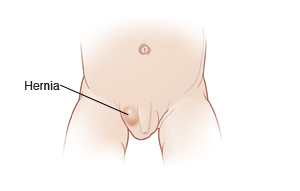Male fetuses have a passage that connects the belly and scrotum. This passage is called the inguinal canal. Female fetuses also have an inguinal canal that connects the belly with the labia. In boys, the testicles form in the belly. Just before birth, the testicles move down through the passage into the scrotum. In females, a ligament from the uterus passes through the passage. In both boys and girls, the passage normally closes before birth. If it doesn't, a loop of the intestine can move down from the belly through the passage in the groin. This is called a hernia. Although females can get inguinal hernias, they're much more common in males.
A hernia may appear as a bulge in the groin (or scrotum in males). It may become more noticeable if your child is crying or struggling.
The condition of the hernia can help determine how quickly it needs to be treated:
-
Reducible. It goes back in by itself, or it can be pushed back in.
-
Irreducible. It can’t be pushed back in.
-
Incarcerated or strangulated. The intestine is trapped (incarcerated). If this happens, you won’t be able to push the hernia back in. If the trapped hernia isn’t treated, it may become strangulated. This means the area loses blood supply and the tissue may die. This needs emergency surgery. Your child needs treatment right away.
To reduce the risk of a simple hernia becoming trapped and becoming serious, surgery is advised for all babies with a hernia.
Home care
Until treatment is scheduled, you may be advised to check your child’s hernia regularly to make sure it doesn’t get worse. Surgery is the preferred choice for hernias that are larger, come back, or cause symptoms.
As long as the hernia can move back into the belly, it’s usually not an immediate problem.
If the hernia gets larger and you can’t push it flat, this is a serious problem. Try to reduce it right away as follows:
-
Lay your child down on their back. Place a few towels under the buttocks to raise the lower body higher than the upper body.
-
Apply gentle steady pressure to the bulge with your flattened fingers or the palm of your hand for up to 10 minutes. If your child appears to be in pain, you’re pressing too hard.
-
The hernia should slide back into the belly.
-
If the hernia doesn't go down after 10 minutes of steady pressure, go to the emergency room (ER).
Follow-up care
Follow up with your child's healthcare provider, or as directed. Your child may need to be evaluated by a surgeon. If imaging tests were done, they will be reviewed by a healthcare provider. You'll be told the results and any new findings that might affect treatment.
When to get medical advice
Call your child's healthcare provider right away or go to your nearest ER if your child has any of these symptoms:
-
Hernia hardens, swells, or grows larger
-
Hernia can no longer be pushed back into place
-
Crying that can’t be consoled
-
Crying or fussing when you touch the hernia
Featured in


